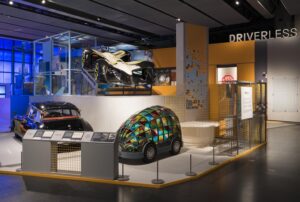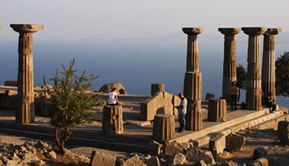Did Homer invent AI?
As a new exhibition opens at The Science Museum, Genevieve Liveley finds some fascinating forerunners of today’s autonomous vehicles in the Homeric epics
 Gallery view of the ‘Driverless’ exhibition at The Science Museum (© Science Museum Group)
Gallery view of the ‘Driverless’ exhibition at The Science Museum (© Science Museum Group)
This summer, the Science Museum welcomed its first visitors to a special exhibition on autonomous vehicles: Driverless: Who is in control? Featuring self-driving cars, autonomous flying drones and un-crewed underwater vehicles, including ‘Boaty McBoatface’, the exhibition, which is open until 5 January, Covid permitting, shows just how close we are to living in a world driven by intelligent machines. Roger Highfield, Science Director at the Science Museum, hopes that the exhibition ‘will highlight how autonomous technology may seem like the stuff of sci-fi but has been around longer than many realise, beginning with our beautiful 1960 Citroen DS19 automatically-guided motor car, which followed the magnetic field from embedded cables in the M4.’
But even in the world of sci-fi and stories, intelligent machines and autonomous vehicles of this kind have been around for a lot longer than many of us realise. Beginning almost 3,000 years ago, we find descriptions in Homer of contraptions such as self-pumping bellows (Iliad, 18.468) and self-opening gates (Iliad, 5.748–52 and 8.392–6) which appear to perform basic tasks with a degree of autonomy. In the Odyssey we also find a pair of robotic silver and gold watchdogs which allegedly possess ‘intelligent minds’. Robot slaves made of gold serve as personal assistants to the god Hephaestus in Iliad, 18.418–22 and have ‘intelligent minds’, too.
It should perhaps come as no surprise, then, to find descriptions in Homeric epic of autonomous vehicles. In fact, there are two kinds of intelligent machine which qualify for this label. In the first known application of this term to a machine, Homer explicitly describes a set of multipurpose tripods as automatos or ‘self-acting’ (Iliad, 18.373–9). These wheeled devices move back and forth between the homes of the gods – presumably delivering food, incense and other divine necessities. And appropriately, Homer tells us that Hephaestus used his self-pumping and self-regulating bellows to make these self-moving devices:
He moved to and fro about his bellows in eager haste; for he was manufacturing tripods, twenty in all, to stand around the wall of his well-built hall. He had set golden wheels on to the base of each one so that of themselves (automatoi) they could enter the assembly of the gods for him and return again to his house, a wonder to see. They were almost fully finished, but the clever handles were not yet fixed upon them. He was making these now, and was cutting the rivets, working away with intelligent understanding…(Iliad, 18.372–81)
Homer gives us a detailed picture of how the tripods are fashioned: golden wheels (kukla) are fixed to the base of each tripod, and their elaborate handles or ‘ears’ (ouata) are attached with metal rivets. This level of mechanical and technical detail is typically absent from other imaginative fictions in the ancient world where self-moving domestic and religious artefacts are described. Athenaeus collects a number of similar examples from ancient Greek fictions, including a table that comes when called, an autonomous bread-mixer, a self-filling ladle and a self-washing cup (Deipnosophistai, 6.267e). These automata, Athenaeus suggests, are marvellous, magical and even a little bit comical. In contrast, Homer’s automata – while they are certainly marvellous – are seriously described, with unusual attention to realism and detail in terms of their manufacture and mechanics.
Indeed, we see a similar attention to technical detail given to the second and most marvellous set of Homer’s autonomous vehicles. Anticipating the Sat Navs and driverless vehicles of our own century, Homer describes ships which need neither pilot nor steering oar. They know exactly where in the world their passengers want to go. They know how to avoid all obstacles along the way, and are indefatigable and invulnerable. What’s more, these imaginary autonomous vehicles ‘navigate by thought’ (Odyssey, 8.555–64). Preparing to send his guest safely home in one of these remarkable vehicles, the Phaeacian king Alcinoos asks Odysseus for his home address so that he can effectively programme the ship’s ‘Sat Nav’:
Tell me your country, your people, and your city, so that my ships can take you there, plotting the course with/in their minds. For we Phaeacians have no pilots, nor steering oars such as they have on other ships; the ships themselves know the minds and thoughts of men, and they know every city and every rich land. They cross the expanse of the sea with great speed, hidden in mist and cloud, and they never have to fear any damage or shipwreck (Odyssey 8, 555–64).
In place of a human pilot to steer them, these ships have phrenes – here representing the intellectual programming by which the ships know the minds and intentions of their human passengers. In fact, the programmed minds of these ships are described by Homer as if they are substitutes for the human minds of their pilots (who will be absent for the voyage) and their passengers (who, in Odysseus’ case, will be asleep for the voyage). Once programmed with the relevant data, these ships can independently plot their course across the sea to a desired location and figure out the best way to get there safely. These autonomous vehicles are programmed by the external knowledge contained in human minds. In Homer’s description they do not have thoughts or minds of their own, but they can use their programming to plan ahead and negotiate practical problems. They can think and act independently within the limits set by their programming. That is, they possess a kind of artificial intelligence.
Indeed, in Homer, as in Greek literature and philosophy thereafter, the human mind itself is typically conceived of as a ‘programmable’ vessel. In Homeric epic, the gods like to place plans and ideas into human phrenes and then watch from a safe distance as men and women take action accordingly. Humans may also call for such programming of their own accord. In the Odyssey, for example, the epic poet Phemius claims that: ‘I am self-taught (autodidaktos), but the god has put into my mind (phresin) all kinds of songs’ (Odyssey, 22.347). And in the Iliad, in Homer’s invocation to the Muses (daughters of Memory), he asks that they ‘remind’ him of – literally that they ‘put into his mind’ – the catalogue of ships that he is about to recite (Iliad, 2.484–93).
The phrenes of the Phaeacian ships seem to function in much the same way as human phrenes, then. That is, they possess both AI and a kind of natural, human intelligence. Alcinoos programmes them – he literally puts into their mind – the details of the final stage of Odysseus’ homeward journey, and they take action accordingly. However, Homer signals to us that the success of the journey critically depends upon the effective management of this programming. He includes a number of small yet significant details in his account of Alcinoos’ commands for the deployment of the ship that is to take Odysseus home. When Alcinoos orders a ship to be made ready for Odysseus, he specifies that it should be one ‘which has never yet made a voyage’ (Odyssey, 7.34–6). The ship that will carry Odysseus home will be untried, sailing out on its maiden voyage. That is, the ship will have no pre-programming or learned experience of its own. Its phrenes will be clean and clear.
Alcinoos further orders that the ship is to be rowed (though not steered – the crew provides engine power only) by fifty-two of the very best of young Phaeacian manhood (Odyssey, 7.36-42). That means no old hands with experiences and ideas of their own will be on board, and no slaves who might take it into their heads (and I use this formulation deliberately) to rebel or mutiny. These autonomous ships will be powered only by young men who will do exactly what Alcinoos commands (Odyssey, 7.49). ‘Strong-minded’ Alcinoos (for this is the literal translation of his name) controls everything in this operation and his instructions are to be carried out to the letter.
Do we perhaps hear in these strict, strong-minded commands a hint of anxiety? Does Homer perhaps not only anticipate the real self-driving cars, the actual autonomous flying drones and the true driverless aquatic vehicles of the twenty-first century, but also anticipate our fears about controlling them? In this light, the thought-provoking title of the exhibition at the Science Museum – Driverless: Who is in control? – conveys some very ancient and very human fears about the future of artificial intelligence. It poses a question that encourages us to engage our own ‘strong minds’ in a debate about how we want to see the artificial intelligence and autonomous technology of myth safely transformed into the stuff of reality.
Driverless: Who is in control? is at The Science Museum until 5 January 2021









